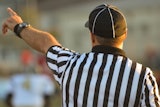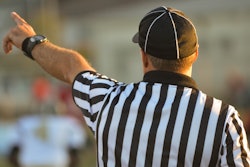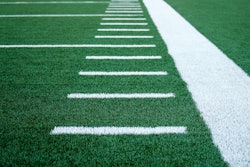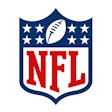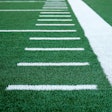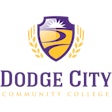![[Photo courtesy of the National Athletic Trainers’ Association]](https://img.athleticbusiness.com/files/base/abmedia/all/image/2020/07/ab.oneONone720_feat.png?auto=format%2Ccompress&q=70&w=400)
Look at the names on nearly any task force assembled to mitigate coronavirus spread in athlete populations and you'll find an athletic trainer near the top of the list. When sports return to daily life in America, it will largely be due to the ongoing efforts of ATs, who serve as the frontline healthcare professionals — and personal confidants — to athletes at every level of competition. AB senior editor Paul Steinbach asked Tory Lindley, senior associate athletic director for health, safety and performance at Northwestern University and current president of the National Athletic Trainers' Association, to describe the unprecedented challenge currently facing his profession.
When you took the NATA post, no one told you a pandemic was coming.
If someone would have even remotely suggested the kind of situation that we’re in… But what we’ve certainly tried to do is create as much opportunity as we can as a healthcare organization. This tends to open a lot of different doors that perhaps were only cracked before.
What are you hearing from your membership in terms of any differences in the way they view their jobs?
There’s been a really strong sense of pride among athletic trainers who in some situations are being recognized for the breadth and depth of their skill set during the pandemic. For others, it’s been an opportunity to be redeployed and apply their skill set to the front lines of treating and managing patients who have suffered from the virus, and that’s been eye-opening for them but also meaningful work, as you can imagine. And then for others, as healthcare administrators, fundamentally, in secondary schools, in the collegiate setting, in a professional sports setting, they’re not only managing athletes day-to-day, but they’re managing the healthcare system day-to-day. And with that has come an entirely different set of responsibility in the midst of a pandemic.
Has monitoring student-athlete illness always been part of the athletic trainer’s day-to-day duties?
It’s been a big part for a long time. The general medical piece isn’t seen quite as much on TV or from the stands. That’s more of a behind-the-scenes, day-to-day management of the general medical health-and-wellness piece. It has a prevention component. Athletic trainers are as good at prevention as any healthcare provider because of our consistent contact with our patient population. When you build that rapport and that trust, then you are going to be listening to the primary complaints, whether it’s an injury or illness. And then our long-standing direct connection with our physicians — whether it be a team physician or physicians in the community, or specialists and experts in our region or all over the country — put athletic trainers in the middle of that healthcare system to be able to direct and refer immediately, or quickly, or when appropriate after they apply their own general medical skill set in that initial evaluation.
You’re the student-athletes’ confidant.
No doubt, which is a component that leads to one thing we haven’t talked about yet. A major part of the AT skill set and a major part of where we’ve been able to flex that skill set has been in the mental health realm, because mental health, whether a student-athlete or one of our patients had a mental health issue prior, the amount of stress and anxiety that the pandemic has put on everyone has been immense. Our athletes, even from a distance, through telemedicine and other forms of communication, have still needed to lean on the athletic trainer. The athletic trainer has been that person who has been checking in — in some cases on a daily basis, even if they’re miles and miles away. So that’s been a huge component and very eye-opening and very necessary to have the AT connected to our patients, to our athletes — even while separated.
And we’re talking about a lot of student-athletes.
Absolutely. Hundreds and hundreds of encounters per week, at least at our institution. And I know that’s the same way it is across college athletics, when I talk to athletic trainers at all levels — Division III, two-year institutions. An athletic trainer has a patient panel of 300, 500, 800 athletes that they’re managing on a day-to-day basis. And that didn’t stop when everyone received their stay-at-home orders.
What do you have to do to make the return to campus this summer as safe as possible?
I look at it this way — we’re not really doing anything new, we’re just doing everything that we had previously done in a different way. If you take one of the things that I’ll talk about and put it under an electron microscope, that one thing becomes one really big thing. And the next thing becomes a really big thing. It’s almost like each of the different systems become its own standalone policy or its own standalone procedure. For example, we’ve always been foundational in our student-athlete health, and that requires an annual physical. Well, when you have an annual physical for a patient who’s returning to campus from a three-month layoff at home, and you add in not only the COVID-19 health concerns but the COVID-19 history of patient contact, the history that you would take takes on an entirely different form. The way that you would conduct that physical has add-ons because of COVID-19. The physical becomes more elaborate before they even walk through the door. We’re going to ask questions before they walk in the door. And then from a system standpoint, we’re going to identify what door they walk in, we’re going to identify what door they walk out, because we have unknowns.
At least initially, some schools are testing and some aren’t upon athletes’ return to campus.
Testing becomes really an institutional decision, which I fully appreciate. As the leader of NATA, I would absolutely want it to be those type of local decisions by university health systems, medical directors, athletic trainers, risk managers, offices of general counsel, university presidents — everybody involved in the decision on the way that they want to approach the student athlete and staff health and safety. So, whatever an institution chooses is the right choice for them. Testing versus non-testing — I think the thing that’s lost in those who choose to not test is the idea of isolation or quarantine. It isn’t just as simple as, “We’re going to take a daily symptom check.” So, they’re combining and in their approach that doesn’t include testing, they’re including a quarantine, which is absolutely appropriate. And we’re also dealing with institutions all over the country. What’s going on right now in Cook County, Illinois, certainly is a much different environment than in Lincoln, Nebraska, and it’s been that way since March. So, all those things weigh in.
What precautions are in place for the athletic trainer?
Prior to any testing of any staff or student-athletes, there are universal precautions, just like everyone else across the country. That includes treating each other as if we’re positive, as if we’re carrying the virus. All of the precautions that go into that have to be put in place. Even in a rehabilitation setting, you’re talking about physical distancing, you’re talking about universal precautions in terms of infectious control with the way that you clean surfaces, with the way you’re wearing personal protective equipment — both the healthcare provider, which is the athletic trainer in this case, as well as the patient, which is your student-athlete. Everything is very, very deliberate. What normally is just kind of taken for granted — you touch a surface. Now, when you touch a surface and you’re not wearing a glove, we’re wiping down high-contact surfaces repeatedly. It’s the things we’ve done, just at a much higher level with a much higher focus on ensuring that it’s always done.
Is there an education component as far as how athletes should be conducting themselves off the field amid this health crisis?
In this particular space and in most situations, the athletic trainer is responsible for working to develop along with others, but develop and deliver predominantly the student-athlete education, whatever it might be. So myriad topics — concussion prevention. This is no different. So, the answer is yes. And in this case, for it to be successful, it certainly has to be an entire institution — understanding and commitment to know the behaviors and the expectations. They still have to be realistic. This isn’t pro sports. We’ll see if there is success in off-the-field isolation in pro sports, but that’s certainly not how a student-athlete at the collegiate level can be treated or how we should expect that they behave when they’re outside of our facility. So it is a key part of the education — athletic trainers in the middle of that education, along with coaches, along with the administration — to just help them to best understand what their best opportunity is to stay safe.
Are you confident that there will be a fall sports season, and do you see hope that it can be done safely, without further outbreaks?
I certainly don’t have any level of predictability on a follow-up spike or outbreak, but what I am very comfortable and confident with is what’s been going on for the past few months. And that is, there are a lot of really smart people in some really important rooms who are making decisions on a day-to-day basis collectively, and those rooms include athletic trainers. So, to have frontline healthcare providers who understand our student-athletes, our patient population, understand the systems, understand workflow on any given day, and the touch points of the staff members in sports performance and in athletic training and in sports nutrition and sports psychology, team physicians, coaches, administrators who are coming in daily contact, there are some really important and really good conversations going on. So, the confidence level I have is that when you take those people and add in some of the epidemiologists and immunologists — the experts who are connected directly to the pandemic — as well as regional and local officials who can understand and appreciate what the risk is when the student-athletes leave our facility, again, I’m confident the decisions that are being made are the right decisions for the information that we have right now.
ATs are often near the top of a task force roster.
I appreciate you noticing that. That’s precisely where we started this conversation — the recognition of the athletic trainer as a frontline healthcare expert, as that healthcare administrator who understands all the key components that go into protecting the health and safety of the student-athlete, as well as returning them in a stepwise progression through a climatization back to activity. And that’s the part we haven’t talked about. Get them in the building. Get through that return-to-campus component. But then, once we put them back on the field, working in concert with strength and conditioning, the athletic trainer is critical on the prevention side, critical in assuring that climatization steps are taken to, again, protect health and safety and to try to get us to a fall season where everybody is feeling as good about our success and our outcomes as we possibly can.
This article originally appeared in the July | August 2020 issue of Athletic Business with the title "The athletic trainer’s role in pandemic response." Athletic Business is a free magazine for professionals in the athletic, fitness and recreation industry. Click here to subscribe.














